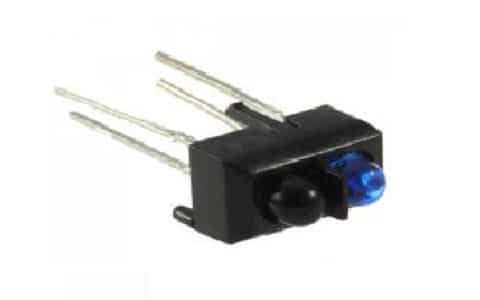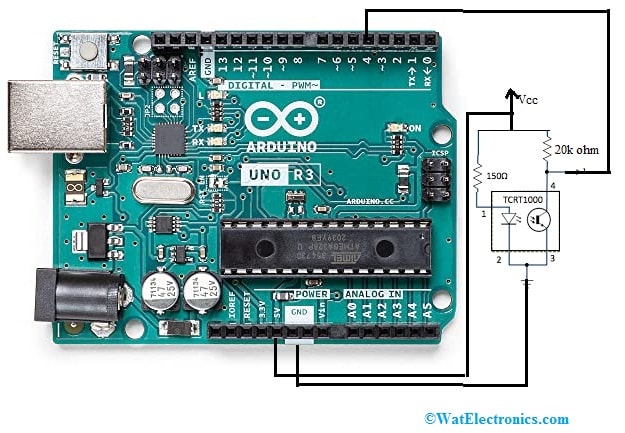A sensor is a device that responds to pressure, thermal energy, acoustic energy, electromagnetic energy, motion, or magnetism by generating an electrical signal. The semiconductor development from 1940 to the 1950s led to compact, less costly, and efficient light-sensing devices like optical sensors. These sensors are mainly developed to enhance the efficiency & reliability of control systems at less cost. Optical sensors are capable of detecting light at a specific electromagnetic spectra range like visible, infrared & ultraviolet. This sensor either detects frequency, the polarization of light, or wavelength & changes it into an electric signal because of the photoelectric effect. So, this article discusses an overview of an optical sensor – working with applications.
What is an Optical Sensor?
An optical sensor definition is; a sensor that is used to convert the light rays into electronic signals. These sensors help in measuring the incident light’s intensity & changing it into a readable form through an incorporated measuring device based on the type of sensor. Generally, this sensor is an essential part of a larger system which includes a light source, sensor, and measuring device itself.
Generally, optical sensors comprise encoders, optical measuring instruments, gratings, optical fibers & other devices. So all these devices help with each other to allow the optical sensor to normally work & precisely measure different data.

Optical Sensor
The characteristic of an optical sensor is; its capability to compute the changes from light beams. So this change frequently depends on the change in the intensity of light. These sensors can function either on a single-point technique or by a distribution of points. The main significance to utilize this sensor is that it holds certain parts of measured properties. It should always stay responsive to the property.
Optical Sensor Working Principle
Optical sensors have the capacity to detect light usually at an exact electromagnetic spectra range like visible, infrared, and ultraviolet. This sensor simply detects the polarization of light, wavelength, or frequency and changes it into an electric signal because of the photoelectric effect. An optical sensor’s detecting principle mainly depends on changes within the optical signal’s characteristics. This sensor works mostly by using light as the medium, thus the distance of its detection is extremely long.
In general, there are two components in optical sensing viz. transmitter (i.e. optical source) and receiver (optical detector). The concept is depicted in the figure with the example of optical fiber. As shown light beam changes its parameters when any object comes in between the transmitter and receiver. There are five useful parameters of light that are being measured in optical sensing viz. intensity, phase, wavelength, polarization, and spectral distribution.
Due to the advent of optical sensing technology, following physical and chemical measurements can be measured. They are; Temperature, flow, pressure, displacement, liquid level, vibration, rotation, acceleration, magnetic fields, force, Ph, radiation, chemical species, humidity, strain, electric fields, velocity, acoustic field, etc.
Types of Optical Sensors
There are different types of optical sensors like Through Beam, Diffuse reflective & Retro-reflective sensors.

Types of Optical Sensor
Through Beam Optical Sensors
Through-beam optical sensor includes both transmitter & receiver which are arranged by pointing to each other so that they can create a directly light ray path. Once any object approaches in the middle of this path then the light intensity will be changed & thus object is detected.
Diffuse Reflective Sensor
This diffuse reflective sensor has both transmitter & receiver which are arranged parallel to each other. Once the transmitter generates a light signal then it is reflected through the object. This light reflection can be simply measured through the receiver.
This kind of sensor is mainly used to execute color differentiation. If the red LED is used as the light source, then differentiating red & white light is difficult because both the red & white color lights have a similar amount of reflection.
Retro-reflective Sensor
This kind of optical sensor has both transmitter & receiver which are arranged within one housing. The transmitter generates a light ray which is reflected through the reflector & obtained by the receiver. If any object approaches in the middle of this light ray path, then it breaks. So the object at the receiver is detected based on the variation between the intensity of the light beam & other parameters.
Optical Sensor Circuit Diagram
An optical smoke alarm is also called a photo-electric smoke alarm which is mainly used in lounges, bedrooms, hallways, etc. This smoke alarm responds very quickly to visibly smoldering fires.
This circuit uses a Transmissive Optical Sensor TCST2103. This sensor mainly includes an IR emitter & phototransistor which are arranged face-to-face on the optical axes within a leaded package so that visible light can be blocked. The dual-comparator like LM393 is connected to switch an exterior electrical load once its non-inverting input level drops under a certain threshold, which is set through the RP1 trimpot connected with its inverting input.

Optical Sensor Circuit Diagram
In the above smoke detector circuit, the R1 resistor is used to restrict the IR LED’s current flow within the optical sensor whereas the R4 resistor restricts the current flow throughout the LED1. The R3 resistor is connected as a pull-up resistor at the IC1 output. This output is mainly used for controlling an exterior circuit to drive very powerful audio or visual annunciators like hooters, beacons, etc.
This circuit can also notice the smoke certainly but with the TCST2103 optical sensor; this circuit monitors the invisible light path constantly in between the light transmitter & receiver and gives an alert simply whenever the light ray is interrupted through solid smoke within the slot of the sensor.
Here, the working principle of this optical smoke sensor is somewhat different compared to commercial optical smoke detectors. In commercial detectors, an IR transmitter irregularly generates an invisible light beam into the IR receiver chamber to verify for smoke particles. Once a fire breaks out then smoke goes into the chamber by using its opening vents & its smoke particles can cause the light ray to be spread onto the IR receiver. When this scattered light strikes the IR receiver then associated electronics in the circuit will make the alarm give an alert to the residents.
Optical Sensor with Arduino
The TCRT1000 is an optical sensor used to detect an object. Here object should not be black because the black color will absorb infrared. The construction of the TCRT1000 sensor is compact wherever the light emitting source as well as the detector is placed in a similar direction to detect the existence of an object with the reflective infrared signal from the object. The detector includes a phototransistor.

TCRT1000 Optical Sensor Interfacing with Arduino Uno
Features
The features of the TCRT1000 reflective optical sensor include the following.
- Package type is leaded.
- The type of detector is a phototransistor.
- Dimensions are 7 x 4 x 2.5mm.
- The operating distance is 1 mm.
- Collector current ranges from 0.2 mm – 4 mm.
- The typical o/p current IC is 0.5 mA.
- The emitter wavelength is 950 nm.
The required components to connect this sensor with Arduino Uno include a TCRT1000 reflective optical sensor, Arduino UNO, breadboard, jumper wires, and resistors like 150 ohms & 20k ohms.
The optical sensor wiring diagram connection follows as; the voltage supply of the TCRT1000 sensor is connected to the 5V pin of the Arduino, the ground pin of this sensor is connected to the GND pin of an Arduino, and pin-4 of this sensor-like phototransistor’s collector pin is given to digital pin-4 (D4) of an Arduino. Once the connections are made, upload the following code into the Arduino and check an LED will be turned on once the object is detected.
Code
int sensor = A0;
int ledIntensity;
int led = 13;
void setup() {
Serial.begin(9600);
pinMode(led,OUTPUT);
}
void loop() {
sensor = analogRead(0);
ledIntensity = map(sensor,30,1023,0,255);
analogWrite(led,ledIntensity);
Serial.println(sensor);
delay(1000);
}
Advantages and Disadvantages
The advantages of the optical sensor include the following.
- These are available in small sizes with less weight.
- Applicable for remote sensing.
- Sensitivity is high.
- Inert chemically.
- The dynamic range is wide.
- It is capable to monitor a wide range of physical and chemical parameters.
- Its operation is reliable.
- Flexibility & Robustness.
- These sensors incorporate an infrared emitter & photodetector within a single package.
- These are capable of providing multiplexed/distributed sensing.
The disadvantages of optical sensors include the following.
- Optical sensors are expensive.
- Vulnerable to physical damage
- Susceptible to intrusion from ecological effects.
- There are different types of losses occurred within the optical domain like absorption, coupler,
- scattering, insertion, impurity, reflection, etc.
Applications of Optical Sensors
The applications of optical sensors are discussed below.
- Optical sensors are used in smartphones for adjusting the brightness of the screen.
- These are used in smartwatches to measure the heartbeat of the person.
- These sensors are available in the energy field for monitoring structures that distribute, produce, & change electrical power.
- These sensors are used as ambient light sensors in mobiles.
- These are used in biomedical applications for breath analysis and heart rate monitoring.
- These are used as water level indicators.
- An optical sensor is used in the liquid level indicators.
- These are essential parts in many common devices like Xerox machines, computers & light fixtures that activate in the dark automatically.
- These are electronic components mainly designed for detecting & changing incident light signals into electrical signals.
- These are very useful in measuring the incident light’s intensity & changing it into a readable form through an integrated instrument.
- These are utilized for detecting contact lenses, counting, and otherwise part detection.
- Optical sensor is used in imaging, remote sensing satellite, metrology, medical devices, and quality & process control-based applications.
- These are used in medical & healthcare, consumer electronics, and industrial or commercial.
- These are utilized in several commercial & research applications for process & quality control, metrology, medico technologies, remote sensing & imaging.
Thus, this is all about an overview of an optical sensor – working with applications. The optical sensor examples are; Avago ADNS-7550, Avago ADNS-2700, Sharp GP2Y0Di10Z0F, and ROHM BH1603FVC. Here is a question for you, what is a proximity detector?